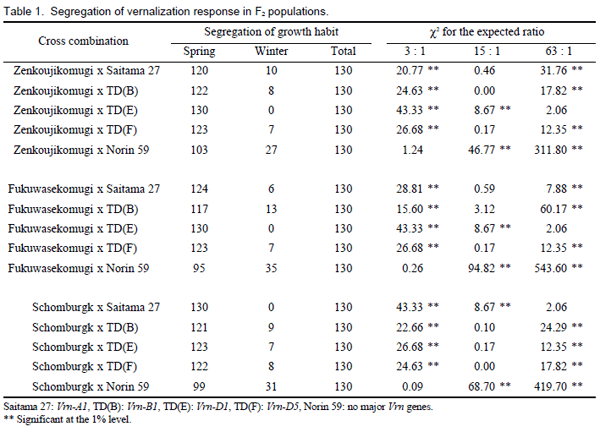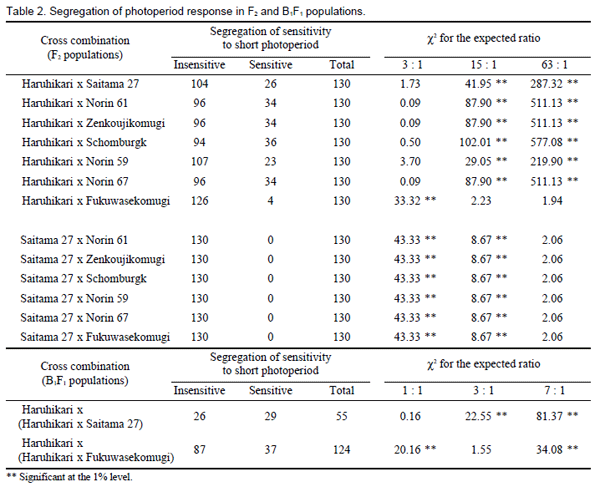Genetic analysis of vernalization and photoperiod responses in one Australian and seven Japanese wheat cultivars
Description
Earliness of heading is one of the most important traits aimed for in wheat breeding. Three physiological characters (vernalization response, photoperiod response, and earliness per se) are responsible for conferring this quality. The major genes for vernalization insensitivity that convert winter wheat into spring wheat are Vrn-A1, Vrn-B1, Vrn-D1, Vrn-D5, and Vrn-B4. Photoperiod response is controlled by three major genes (Ppd-A1, Ppd-B1, and Ppd-D1), which make wheat insensitive to day length. It has been reported that wheat cultivars indigenous to Japan carry Vrn-D1, whereas the Vrn genotype of several important Japanese cultivars remains to be investigated. On the other hand, the Ppd genotype has not been identified in any Japanese wheat cultivars or lines. In the present study, we analyzed the genotype for the response to vernalization and photoperiod in seven Japanese wheat cultivars, Haruhikari, Saitama 27, Norin 61, Zenkoujikomugi, Norin 59, Norin 67, and Fukuwasekomugi, and one Australian wheat cultivar (Schomburgk). Among the eight cultivars, the Vrn genotype of three cultivars, Haruhikari, Saitama 27, and Norin 61, have been identified as Vrn-A1, Vrn-B1, Vrn-A1, and Vrn-D1, respectively, and two cultivars, Norin 59 and Norin 67, have a winter growth habit and therefore carry no major Vrn genes.
Allelism testing of the genes for vernalization response showed that three cultivars, Zenkoujikomugi, Fukuwasekomugi, and Schomburgk, carried Vrn-D1, Vrn-D1, and Vrn-A1, respectively (Table 1). It was found that the number of days to heading at 20°C under an 8-hour photoperiod after green vernalization at 5°C under an 8-hour photoperiod for 70 days indicated the degree of sensitivity to short photoperiod. Among the eight cultivars tested, Haruhikari was sensitive to short photoperiod, while the others were insensitive. Segregation analysis of photoperiod response in F2 and B1F1 populations showed that the cultivar Haruhikari carried no major Ppd genes for insensitivity to photoperiod. On the other hand, six cultivars, Saitama 27, Norin 61, Zenkoujikomugi, Schomburgk, Norin 59 and Norin 67, carried a single, identical Ppd gene for insensitivity, and the cultivar Fukuwasekomugi carried two Ppd genes for insensitivity (Table 2). This genetic information on vernalization and photoperiod response will be useful in wheat breeding.
Figure, table
- Affiliation
-
Japan International Research Center for Agricultural Sciences Okinawa Subtropical Station
- Classification
-
Technical A
- Term of research
-
FY2004(FY2002~2005)
- Responsible researcher
-
TANIO Masahiko ( Okinawa Subtropical Station )
TAMURA Yasuaki ( Okinawa Subtropical Station )
SATO Mitsunori ( Okinawa Subtropical Station )
TAKAGI Hiroko ( Okinawa Subtropical Station )
MATSUOKA Makoto ( Agriculture, Forestry and Fisheries Research Council Secretariat, Ministry of Agriculture, Forestry and Fisheries )
KATO Kenji ( Okayama University )
- ほか
- Publication, etc.
-
TANIO, M. et al. (2004) Breeding research 6 (Suppl 1) , 135
- Japanese PDF
-
2004_18_A3_ja.pdf619.84 KB


